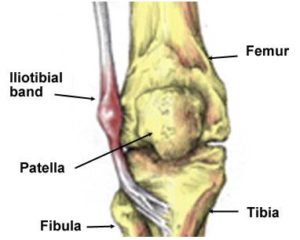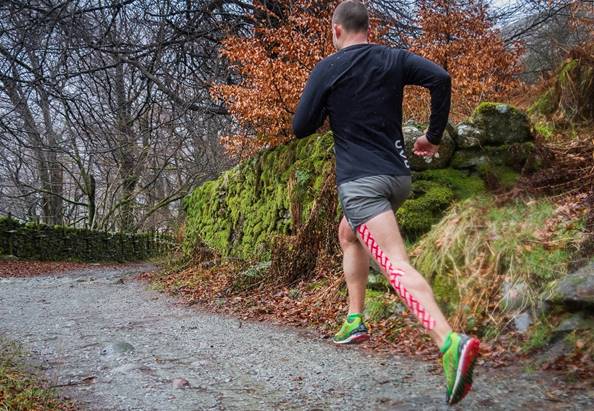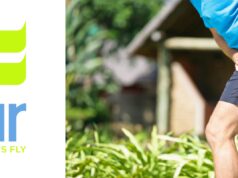Here’s a guide for you to help deal with the dreaded runners knee pain. I’ll start off by giving you a quick overview of the mechanics of the injury, and how to identify if you’re suffering from it. You’ll then be given some top tips on how to deal with runners knee, or even better stop it happening in the first place.
[restrict userlevel=”subscriber”]
Runners knee or Iliotibial band friction syndrome is a painful condition that affects the outside of the knee joint. The Iliotibial band (ITB) originates from the tensor fascia latae (TFL) muscles, it extends down the outside of the thigh to the top outer edge of the tibia (shin bone).
 When running the ITB continually passes over the outer edge of the thigh bone where there’s a small prominence of bone, bursa (small fluid sacs) lie between the bone and ITB to help provide a smooth movement. Any changes to the normal movement patterns of the body can increase the amount of rubbing and friction around the outside of the knee, which will result in the ITB or bursa becoming inflamed.
When running the ITB continually passes over the outer edge of the thigh bone where there’s a small prominence of bone, bursa (small fluid sacs) lie between the bone and ITB to help provide a smooth movement. Any changes to the normal movement patterns of the body can increase the amount of rubbing and friction around the outside of the knee, which will result in the ITB or bursa becoming inflamed.
What you need look out for
Pain on the outside of your knee is the first sign you may be suffering from runners knee, the pain usually comes on gradually when running, but is sometimes a sudden onset. If you’re already suffering with runners knee you generally start your run pain free and after about 10 minutes you’ll start to feel the pain come on. The pain doesn’t usually get any worse throughout your run, but going up and down hills will probably aggravate it. If it really flares up you’ll feel pain as soon as you start running and even when walking, especially going up and down the stairs.
You’ll get swelling and a tender spot on the outside of your knee, it’s usually easier to find the tender area when you’re knee’s bent. Something else you may experience is a snapping sensation on the outside of your knee, this is the taut ITB jumping over the bone.
So what actually causes it?
Due to the repetitive nature of running, if there’s a bit of friction between the ITB and the bone it will constantly rub, causing soreness and pain. Due to this runners knee is classed as an overuse injury, it is associated with long distance running – so if you’re building your mileage up for a marathon watch out for it!
As mentioned earlier, changes in movement patterns can cause runners knee. Two of the most common causes are when your foot rolls in too much (over-pronation), or when you have excessive tension in your TFL and weakness in your gluteus medius (Gmed). The TFL can become very tight to compensate for weakness in the Gmed, this can be as a results of sitting down for long periods of time, i.e. working at a desk or driving all day.
Here’s what you can do
Start by reviewing your training over the last few weeks, have you changed anything; a sudden increase in mileage, new trainers, recently added hill sessions, change the surface you run on, etc. What are you doing the rest of the time, have you started sitting down more or changed your work footwear. It’s usually what we’re doing throughout the day that affects how efficiently our body’s move, i.e. carrying your child, playing computer games, working in an awkward position, etc. Certain activities can’t always be avoided, but there are always ways to adapt the situation to improve things.
The next thing to do is analyse how your body’s moving and which movements cause the pain. A simple way to check your lower body symmetry is to look at the way you stand; is one leg/foot turned out more than the other, or are your hips tilted forward? This is something you can correct with a good strengthening and stretching routine. Also check the wear on your trainers, is there more wear on the inside of your heel? This is a good indication you’re over-pronating, if this is the case you may want to go to a podiatrist to have orthotics fitted. You could try using standard medial supports and strengthening your lower leg muscles first, to see if this corrects the problem.
Another simple thing to do is make sure you’ve got trainers that suit your body and running style. Always get your trainers from a running shop, they’ll be able to make sure the trainers are right for you, with the right amount of support and designed specifically for running. I would always recommend trying trainers on before buying them, this way you and the running shoe specialist can make sure they fit properly.
The road to recovery
The first thing to do is limit any activity or movement that’s causing the pain, but carry on doing other pain free activities, I.e. swimming or cross-training. What you can do will very much depend on the stage of your injury, but one thing you really want to avoid at all stages is downhill running as this aggravates it the most.
Initally you can apply ice for 10-15 minutes to the swollen area 2-3 times a day, this will reduce the inflammation around the outside of the knee.
Applying kinesiology tape to off load the TFL and ITB can really help; this is great if the pain is there when walking, or if you are on a tight race schedule. The tape often takes enough pressure away from the painful area to allow you to run on flat ground pain free. Below is a picture showing how the tape is applied to the ITB, when applying the tape it’s important to make sure there’s no stretch at each end, but you can apply around 50% stretch through the rest of the tape. Apply the tape along the length of the ITB and cross a smaller piece over the area of pain. You can apply the tape in a similar way to offload your TFL; put a smaller piece along the length of the muscle, then apply two pieces at the top and bottom of the TFL going back toward the glutes.
 Releasing you TFL will take tension out of the ITB thus reducing the amount of friction at the point on the outside of your knee, you can do this by stretching your TFL or by using a ball or foam roller to release it. When releasing the TFL you want to lie on your side with the ball or roller under your hip pushing into your TFL muscle, you’ll know when you’ve got the spot because it will be very sore! Stay in this position for 3-5 minutes, just moving gently around the area so that all the tension is released.
Releasing you TFL will take tension out of the ITB thus reducing the amount of friction at the point on the outside of your knee, you can do this by stretching your TFL or by using a ball or foam roller to release it. When releasing the TFL you want to lie on your side with the ball or roller under your hip pushing into your TFL muscle, you’ll know when you’ve got the spot because it will be very sore! Stay in this position for 3-5 minutes, just moving gently around the area so that all the tension is released.
I’d recommend following the above steps for 1 to 2 weeks, or until the pain has reduced and you feel looser on the outside of your hip and down the outside of your thigh and knee.
Now is a good time to start strengthening your Gmed and Quads, strengthening these muscles will help keep your knees stable and when running. Here’s some great exercises for you to do, along with some tips to make sure your targeting the right muscles when perform them:
Clam – Make sure you keep your hips straight when doing this exercise (be careful not to let them fall back as you raise your knee), and you’ll really feel your Gmed working.
Side lying leg raise – If you turn your foot out when doing this exercise it will really activate your Gmed, the movement up and back down should be smooth and controlled.
Hip hike – This is a really good and very specific movement for running, as you’re working the muscles in exactly the same way as when you’re running (Gmed works to stop your hip from dropping).
Terminal leg extension – This exercise will help stabilise your knee in the phase of running when your foot hits the ground, there’s a lot of force going through your leg at this stage so your quads have to work hard to keep everything stable.
Leg extension – When doing this exercise make sure your knee is in alignment (foot straight forward), or you may find turning your foot in slightly helps as this brings more emphasis to your medial quadriceps muscle, that’s crucial in the stabilisation of your knee.
These exercise have been selected to strengthen the muscles around the knees and hips, this will optimise movement of the knee joint without aggravating the injury. All of the exercises should be perform with a slow controlled movement throughout, concentrating on your technique. For images showing how the exercises are performed go to www.jb-sporttherapy.co.uk.
If you still have pain after following this guide or have any concerns along the way, I recommend getting your injury checked out by a professional.
I hope you’ve found this useful, if you have any questions please get in touch with me via twitter or facebook.
Thanks for taking the time to read this and happy running to you all.[/restrict]






